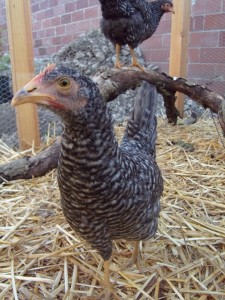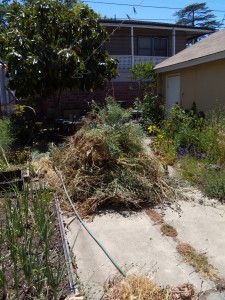Kelly is everyone’s favorite around here. She is Pudy’s soul mate snuggler, and superstar provider of scrumptious treats to the chickens. Unfortunately for all of us, she is on vacation, basking on the sunny banks of the Sacramento River and enjoying the company of dear friends. We in the garden are happy for her, and we’re getting by for the most part.
Pudy lives with the consequences of avian infanticide
Pudy is under house arrest after successfully hunting a baby Bewick’s Wren this afternoon and dropping it dead at my feet. I suspect she also killed its sibling yesterday, and I’m unsure whether the poor parents have any children left in the nest.

Bird killer turned napper, Pudy is a good sport about her temporary confinement.
Treat-crazed chickens settle into outdoor living
The chickens are growing like weeds now that they have sunlight and room to run around. They come up hopefully each time I pass by, and I finally rewarded them this afternoon with a handful of the special treat mix Kelly made. It’s a blend of corn, flax, nutritional yeast (is that even good for chickens?!), and I don’t know what else. The girls go crazy for it.

Petunia is the braver and more curious of the two hens.
For the past three nights, the hens have been putting themselves to bed. As afternoon wears on, they watch for me from the corner of the run. If I come in to visit, Petunia flies up to my shoulders to hang out, while Lu paces around, tortured by indecision. She finds direct human contact distasteful and threatening, but she hates being left out.
Just before dusk, the girls dutifully head up the ramp into the coop and find spots to sleep on the roost. They are almost too adorable for me to bear, and I am so impressed by their grownup ways.
Sarah goes out on a culinary limb
Like the chickens, the weeds are also growing like weeds. I spent time this evening pulling them, along with overgrown beets, and shriveled carrots. I managed to get the ‘Sweet Meat’ squash planted, as well as my precious ‘Bushy Pickling’ cucumbers.
Then I ambled around to the front yard to see what trouble I could stir up. The loquat tree, which served as a great winter bee food source from December through February, is full of fruit. For the past week, I have watched a band of squirrels devouring the fuzzy yellow globes.

The neighborhood snack spot.
The night was young. I set up a ladder and climbed into the tree’s branches, a grocery bag tucked under my arm. I managed to harvest just over four lbs. of loquats. Turns out, this equals a little over two lbs. of edible fruit (thank you, fabulous hanging produce scale!).
What does anyone do with loquats besides eat them off the tree? I turned to my trusty laptop and found that some folks do indeed make loquat jam. I combined two recipes I found online. All told, it took me three hours to produce five little half pint jars of jam (it may end up more like a thick sauce). I was particularly happy that every last jar sealed with a satisfying pop.

One of the five limited edition jars of loquat jam.
I’m exhausted, but undeniably pleased. I’ve always enjoyed the flavor of loquats, and from tonight’s spoon-lickings, I think the jam will be delicious. If Kelly’s lucky, I might even share some with her when she gets home.
For more loquat ideas and a detailed recipe check out our post, How to Make Loquat Liqueur.












